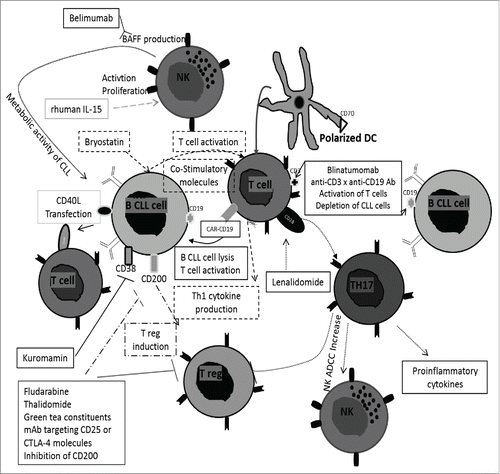Figures & data
Table 1. Immune cells downregulated or upregulated that participate in the defective immune responses observed in CLL.
Table 2. Phenotypic characteristics of B CLL as regulatory B cells.
Figure 1. Immunotherapies based on regulatory B characteristics of B CLL cells. Several immunotherapies are based on the re-education of T cell activation. They are mediated by bryostatin with expression of co-stimulatory molecules and Th1 cytokine production, the T CAR targeting CD19 on B CLL cells, transfection of CD40L into B CLL cells, use of blinatumomab (anti-CD3xanti-CD19 bispecific Ab), polarized DC and lenalidomide leading Th17 expansion and production of pro-inflammatory cytokines. Other immunotherapies use the modulation of T regs. This could be realized by blockage of CD200 on B CLL cells and thalidomide, fludarabine, green tea constituents and mAb targeting CD25 or CTLA-4. Finally, stimulation of NK cells and increase of ADCC are realized by recombinant IL-15 and lenalidomide. NK cells can produce BAFF after binding of the anti-CD20 Ab rituximab to NK Fc receptor. A neutralizing anti-BAFF Ab, belimumab, prevents metabolism of CLL cells and restores efficacy of NK cells. Kuromamin, a CD38 inhibitor causes a decrease of CLL cells in the bone marrow and in the spleen but also, an increase in the peripheral blood. Ab, antibody; ADCC, antibody dependent cellular cytotoxicity; CAR, chimeric zntigen receptor T-cell therapy; CD40L, CD40 ligand; CLL, chronic lymphocytic leukemia; CTLA-4, (cytotoxic T-lymphocyte-associated protein 4); DC, dendritic cell; mAb, monoclonal antibody; NK, natural killer; Rhuman IL-15, recombinant IL-15; Th, T helper; T reg, regulatory T cells.

